Are you looking to continue gardening despite physical limitations? You don’t need to give up your favorite hobby as you age or manage mobility challenges. Adaptive gardening equipment can transform your experience, making tasks easier on your body while still allowing you to nurture your plants. The right tools minimize strain, prevent injury, and extend your gardening sessions. Discover how these five specialized equipment options can help you maintain your garden independence and reconnect with the soil.
GROWIT Heavy Duty 22-Piece Garden Tool Set
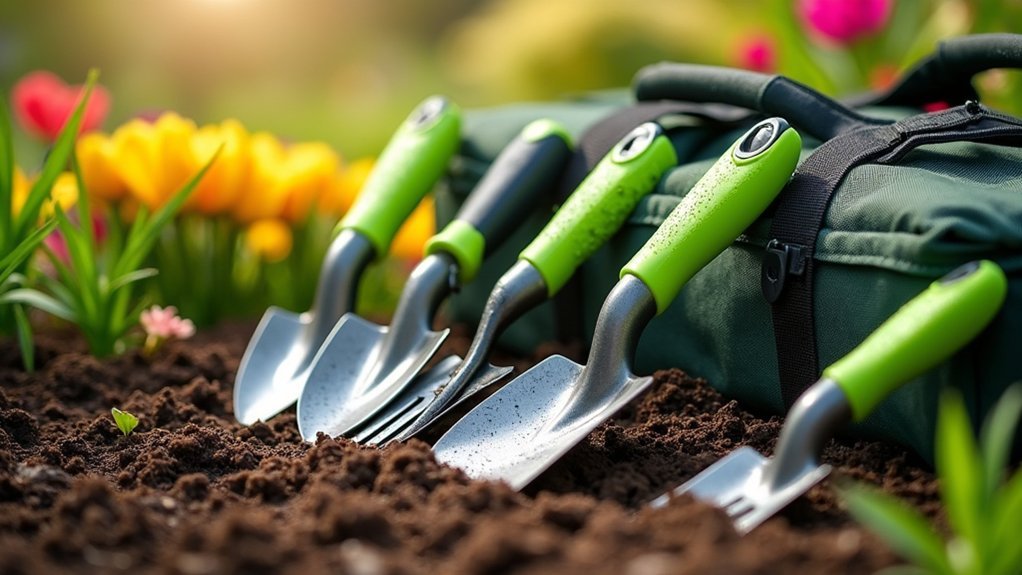
Three key features make the GROWIT Heavy Duty 22-Piece Garden Tool Set an ideal choice for gardeners with mobility limitations or joint pain. Its ergonomic design considerably reduces hand fatigue during extended use, while the lightweight aluminum alloy construction provides strength without adding unnecessary weight to your movements.
You’ll find all essential tools in one package—transplanter, trowel, hand rake, weeder, pruner, plant tags, gloves, and a storage bag. The high-quality materials resist rust and corrosion, extending the tools’ lifespan. With a 4.6-star rating from over 800 users, this complete set delivers both comfort and functionality for adaptive gardening needs.
Best For: Gardeners with mobility limitations, joint pain, or anyone seeking a comprehensive, lightweight tool set that reduces hand fatigue during extended gardening sessions.
Pros:
- Complete 22-piece set includes all essential gardening tools in one purchase, eliminating the need for separate tool acquisitions
- High-quality aluminum alloy construction offers excellent durability while remaining lightweight and resistant to rust
- Ergonomic handle design significantly reduces hand strain and makes the tools accessible for people with various strength capabilities
Cons:
- Storage bag may be too small to comfortably fit all tools according to some customer feedback
- Included gloves might not fit all hand sizes properly, potentially requiring separate glove purchase
- Limited tool selection for specialized gardening tasks that might require additional purchases for serious enthusiasts
Phoenix Vine Heavy Duty Shovel Set of 3 for Gardening (25-SL-3)
The Phoenix Vine Heavy Duty Shovel Set offers aluminum construction that’s particularly beneficial for gardeners with limited hand strength or mobility issues. At just one pound total weight, you’ll find these tools easy to maneuver while still providing functionality for light gardening tasks.
The three different sizes (ranging from 7.3 to 10.6 inches) give you options depending on your project’s requirements. They’re excellent for transplanting houseplants, scooping potting soil, and handling bird seed. However, if you have larger hands or need tools for heavy-duty digging in compacted soil, you may want to evaluate alternatives with more substantial handles.
Best For: Home gardeners with limited hand strength who need lightweight tools for indoor plant maintenance, potting soil transfer, and other light gardening tasks.
Pros:
- Set of three different-sized shovels provides versatility for various small gardening projects
- Lightweight aluminum construction (1 pound total) makes them easy to handle for those with mobility issues
- Attractive silver design makes them suitable for both functional use and decorative display
Cons:
- Small handle size makes gripping difficult for users with larger hands
- Not sturdy enough for digging in hard clay or compacted soil
- Less durable than heavier-duty garden tools for intensive outdoor gardening tasks
Gardening Tools 9-Piece Heavy Duty Hand Tools Set with Garden Organizer Handbag
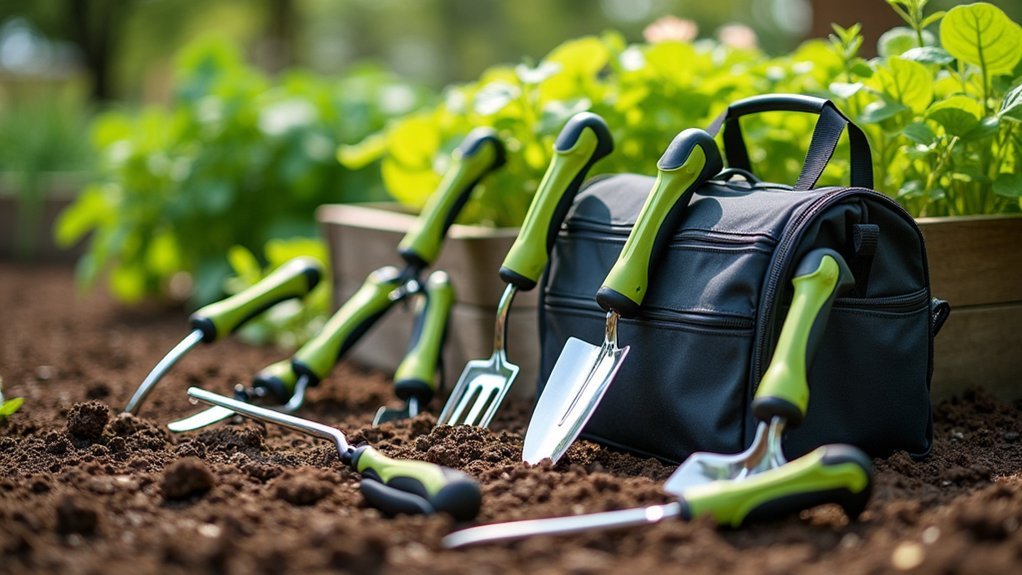
Gardeners with physical limitations will find the Grenebo 9-Piece Heavy Duty Hand Tools Set particularly accommodating due to its ergonomic wooden handles designed for various hand sizes. The non-slip grip guarantees secure handling while performing essential gardening tasks.
The set includes pruning shears, weeder, transplanter, cultivator, and other essential tools crafted from high-strength stainless steel that won’t rust. Everything stores neatly in the included floral-patterned tote bag with specialized tool compartments.
Weighing just under 3 pounds, this highly-rated kit (#2 in Garden Tool Sets) offers accessibility without sacrificing durability—a practical solution for gardeners who need reliable, comfortable equipment.
Best For: Gardening enthusiasts with physical limitations who need comfortable, ergonomic tools with secure grips and convenient storage options.
Pros:
- Ergonomic wooden handles with non-slip grip accommodate various hand sizes, making gardening more accessible for those with hand strength or dexterity issues
- High-strength stainless steel construction ensures durability and rust resistance for long-term reliability
- Organized storage solution with the included floral-patterned tote bag keeps all tools easily accessible and transportable
Cons:
- At 2.99 pounds, the complete set may still be somewhat heavy for users with severe strength limitations
- Some customers have reported color discrepancies between advertised images and actual product
- Limited warranty information available only through manufacturer, potentially complicating support for quality issues
Radius Garden NRG103 103 Ergonomic Aluminum Hand Cultivator, Original Green
Designed specifically for those with arthritis, limited hand strength, or carpal tunnel syndrome, the Radius Garden NRG103 Ergonomic Aluminum Hand Cultivator transforms gardening from a painful chore into an enjoyable activity.
Its award-winning Natural Radius Grip features an over-molded non-latex thermoplastic handle that reduces wrist stress and provides superior comfort. You’ll appreciate the ultra-lightweight aluminum blade that’s sharper than steel yet never rusts.
The talon-like tines effectively turn soil, uproot weeds, and pull out stubborn roots with minimal effort. Users consistently praise its sturdiness and ergonomic design, often calling it an extension of their arm that makes gardening efficient again.
Best For: Gardeners with arthritis, limited hand strength, or carpal tunnel syndrome who need an ergonomic, lightweight tool that reduces hand and wrist stress during soil cultivation and weeding tasks.
Pros:
- Award-winning ergonomic design with Natural Radius Grip significantly reduces hand and wrist stress during extended gardening sessions
- Ultra-lightweight aluminum blade provides superior durability without rusting, while being sharper and stronger than traditional steel alternatives
- Talon-like tines effectively handle multiple gardening tasks from turning soil to uprooting weeds with minimal physical effort
Cons:
- Higher price point compared to standard hand cultivators on the market
- At 13.38 inches long, may be too large for working in very confined planting spaces
- Some users might need time to adjust to the unique curved handle design despite its ergonomic benefits
Ergonomic Hand Tools Set for Weak Grip (Set of 3)
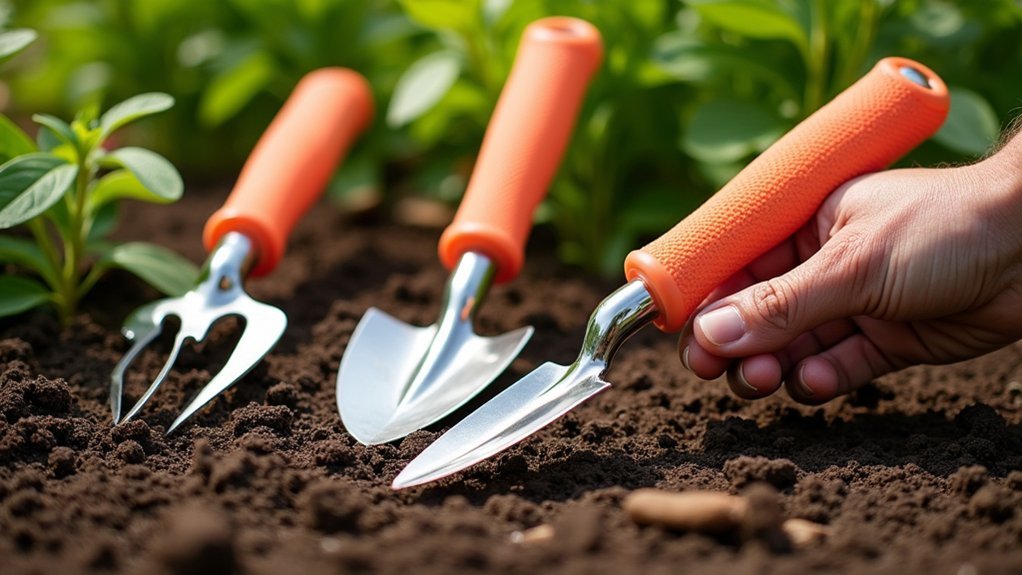
Individuals with arthritis, weak grip, or limited hand strength will find the Ergonomic Hand Tools Set transformative for their gardening experience. This three-piece set includes essential tools—cultivator, trowel, and fork—all crafted from durable carbon steel.
You’ll appreciate the thoughtfully designed TPR rubber handles that provide comfortable, non-slip grip even in wet conditions. Weighing just 1.89 pounds, these lightweight yet sturdy tools adapt to various indoor and outdoor gardening tasks.
Perfect for seniors and anyone needing hand assistance, this highly-rated set makes an excellent gift. The compact dimensions (3.94 x 3.94 x 3.94 inches) guarantee easy storage while delivering professional-quality performance for all your gardening needs.
Best For: Seniors, individuals with arthritis, weak grip, or limited hand strength who enjoy gardening but struggle with conventional garden tools.
Pros:
- Ultra-ergonomic TPR rubber handles provide exceptional comfort and stability for those with reduced hand strength
- Durable carbon steel construction ensures long-lasting performance while maintaining a lightweight design (1.89 pounds)
- Versatile three-piece set (cultivator, trowel, fork) covers all essential gardening tasks both indoors and outdoors
Cons:
- Limited customer feedback available with only one rating, making it difficult to assess long-term durability
- Higher price point compared to standard garden tool sets without ergonomic features
- Compact dimensions (3.94 x 3.94 x 3.94 inches) may be too small for certain larger gardening tasks
Factors to Consider When Choosing Adaptive Equipment for Gardening
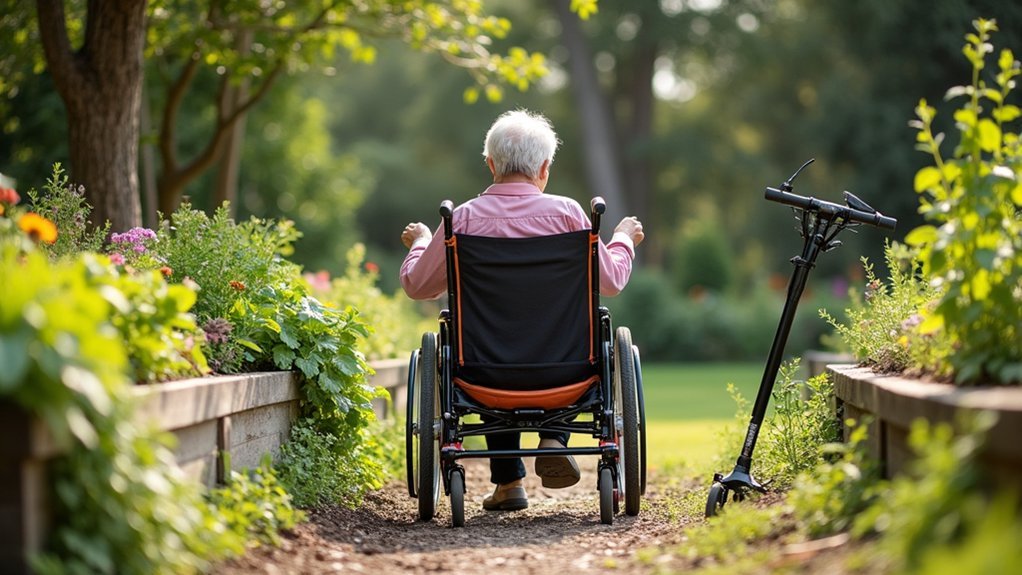
When selecting adaptive gardening equipment, you’ll want to prioritize tools with ergonomic handle designs that reduce strain on your joints and muscles. Consider the weight balance of each tool, ensuring it’s light enough for extended use but substantial enough to perform effectively. Don’t overlook grip size options and material durability, as these factors greatly impact your comfort and the longevity of your gardening investment.
Subheading Discussion Points for “Factors to Consider When Choosing Adaptive Equipment for Gardening”
Selecting the right adaptive gardening equipment requires careful consideration of several key factors that can greatly impact your gardening experience. Look for tools with ergonomic, non-slip handles featuring TPR rubber grips that reduce strain for arthritic hands or limited strength.
Choose lightweight yet durable materials like aluminum or stainless steel to minimize fatigue during extended use while ensuring longevity. Tool dimensions matter—ensure handle length and tool weight accommodate your specific needs and hand size for secure control.
Don’t overlook the importance of having specialized tools for different tasks. Weeding, digging, and transplanting each benefit from purpose-designed equipment. Finally, consider storage solutions with dedicated compartments to keep your tools organized and accessible, making your gardening routine more efficient and enjoyable.
Ergonomic Handle Design
Comfort starts with the handle when choosing adaptive gardening tools. Look for designs specifically crafted to reduce hand and wrist stress, which is vital if you have arthritis or limited hand strength. The best ergonomic handles promote a natural grip position, allowing you to leverage your strength efficiently while gardening.
Non-slip materials are fundamental features to take into account, as they’ll provide better control in wet conditions and during extended use. You’ll also want to prioritize lightweight tools that minimize fatigue during your gardening sessions. Remember that specialized ergonomic designs aren’t just about comfort—they greatly enhance your ability to dig, weed, and plant effectively. When selecting adaptive equipment, always test how the handle feels in your hand to verify it matches your specific needs.
Tool Weight Balance
Beyond handle design, proper weight distribution plays a critical role in adaptive gardening tools. You’ll find that lightweight, well-balanced equipment considerably reduces strain on your hands and wrists, allowing you to garden longer without fatigue.
When selecting tools, prioritize those with weight evenly distributed throughout the design. This balance enhances your control and precision during planting or digging tasks while minimizing the effort required. For those with arthritis or carpal tunnel syndrome, this consideration becomes even more essential.
The ideal balance strikes a compromise between maneuverability and functionality—tools should be light enough to handle comfortably but substantial enough to perform effectively. By choosing properly balanced equipment, you’ll maintain better posture and reduce your risk of injury while enjoying your gardening activities with greater comfort.
Grip Size Options
While many gardeners focus primarily on tool functionality, grip size remains a fundamental consideration that can greatly impact your gardening experience. Tools with handles that are too small can cause discomfort and reduce your control during use, particularly during extended gardening sessions.
Look for ergonomic options with larger grips designed specifically for those with limited hand strength. These accommodate various hand sizes while reducing strain and improving handling. Non-slip rubber handles provide additional security, especially in wet conditions, making tools easier to manage if you have a weaker grip.
Many adaptive gardening tools now feature adjustable grip sizes to suit your personal preferences. When selecting tools, prioritize comfort—proper grip size helps prevent fatigue and pain, particularly if you have arthritis or other hand strength limitations.
Material Durability
The durability of materials used in adaptive gardening tools directly impacts their functionality and longevity. When selecting equipment, prioritize high-quality aluminum and stainless steel options that offer superior rust resistance and strength—essential qualities for tools that will contact soil regularly.
Look for thickened aluminum or high-strength stainless steel construction to prevent bending or breaking during intensive gardening tasks. These materials hold up well even when you’re working with compacted or rocky soil.
Consider eco-friendly, non-toxic materials that maintain their integrity while being safer for both you and your garden ecosystem. Remember that durable materials often complement ergonomic designs, creating tools that remain comfortable and effective through extended use.
While proper maintenance extends tool life, starting with durable materials will greatly reduce your need for replacements.
Storage Accessibility
Effective storage solutions represent a critical factor when selecting adaptive gardening equipment, particularly for gardeners with mobility challenges or dexterity limitations. Choose tools that come with integrated storage systems like tote bags or organizers to keep everything within easy reach and eliminate frustration.
Look for options with specialized compartments or hanging holes that allow quick retrieval and reduce searching time. Ergonomic designs with built-in storage minimize the need to bend or reach excessively—a significant advantage if you have limited mobility.
You’ll also want lightweight, portable storage that lets you transport tools effortlessly around your garden. Don’t compromise on durability; verify your storage solutions are weather-resistant to protect tools from the elements while maintaining accessibility year-round.
Task-Specific Functionality
Just as accessibility impacts your gardening experience, selecting tools with proper task-specific functionality can transform difficult gardening tasks into manageable ones. When choosing gardening equipment, look for designs that match your specific needs, whether it’s digging, weeding, or planting.
Pay attention to ergonomic features that reduce strain during extended use, particularly if you have limited strength or arthritis. High-quality materials like stainless steel or aluminum guarantee your tools will withstand various soil conditions and last longer.
Consider features that enhance control, such as non-slip grips and lightweight construction—these make delicate tasks like transplanting seedlings much easier. Specialized shapes, like concave scoops for soil transfer, can greatly improve your efficiency and results. The right task-specific tool can mean the difference between frustration and enjoyable, productive gardening.
Frequently Asked Questions
How Can I Adapt Garden Equipment for Wheelchair Users?
You can adapt garden equipment for wheelchair users by adding extendable handles, using ergonomic grips, installing raised beds, attaching tool holders to wheelchairs, and choosing lighter-weight tools for easier maneuverability while gardening.
Are Adaptive Gardening Tools Covered by Insurance or Medicare?
Some adaptive gardening tools may be covered by Medicare if prescribed by a doctor as durable medical equipment. You’ll need to check with your specific insurance plan, as coverage varies widely between providers.
What Gardening Techniques Minimize Pain With Arthritis?
You’ll reduce arthritis pain by using raised beds, ergonomic tools with padded grips, container gardening, and alternating tasks. Take frequent breaks, garden during low-pain times, and don’t overextend your joints while working.
How High Should Raised Beds Be for Accessibility?
For ideal accessibility, you’ll want raised beds between 24-36 inches high. This height prevents bending while allowing wheelchair users to reach plants comfortably. You can customize based on your specific mobility needs.
Can Adaptive Gardening Tools Be Used by Children?
Yes, children can use adaptive gardening tools. You’ll find kid-sized versions with ergonomic grips, lightweight materials, and colorful designs that make gardening fun while accommodating different abilities and developing motor skills.

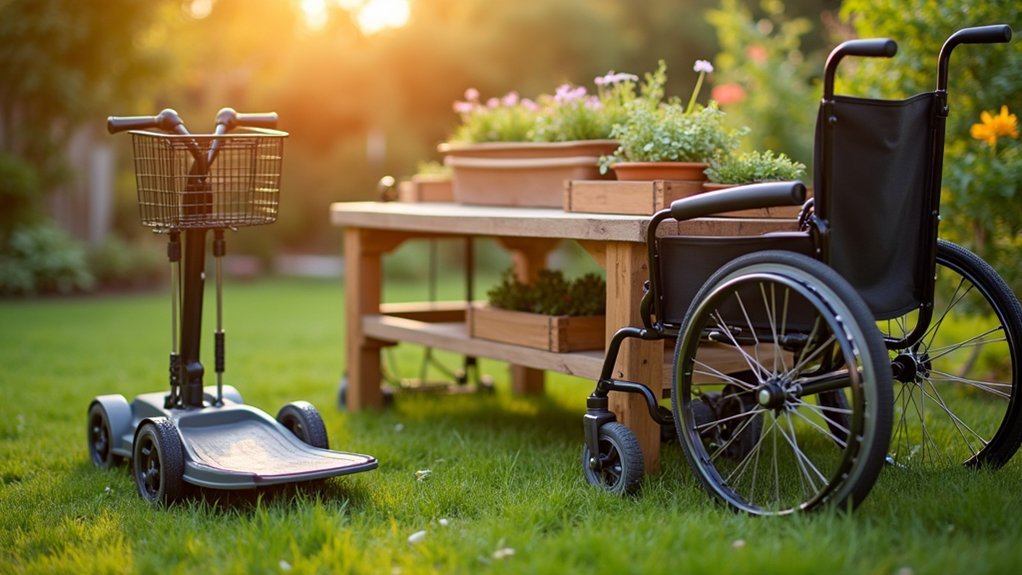



Leave a Reply